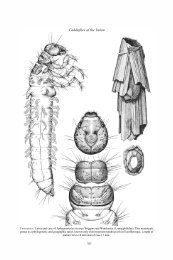Orthopteroids (Orthopteroidea) of the Yukon (V.R. Vickery)
Orthopteroids (Orthopteroidea) of the Yukon (V.R. Vickery)
Orthopteroids (Orthopteroidea) of the Yukon (V.R. Vickery)
You also want an ePaper? Increase the reach of your titles
YUMPU automatically turns print PDFs into web optimized ePapers that Google loves.
226 V.R. <strong>Vickery</strong><br />
warm wea<strong>the</strong>r. So far as I know, no search has been made for grylloblattids in <strong>the</strong> <strong>Yukon</strong>.<br />
Storozhenko (1991) recorded new genera and species <strong>of</strong> Upper Permian grylloblattids and<br />
Storozhenko (1992) reported on fossil grylloblattids from Permian deposits near Archangel,<br />
Russia, but <strong>the</strong>re are no records to date <strong>of</strong> fossil grylloblattids in Canada. Since <strong>the</strong> original<br />
discovery <strong>of</strong> this interesting group <strong>of</strong> insects in western Canada by Walker (1914), additional<br />
extant species, many in <strong>the</strong> genus Galloisiana, have been found in Kirin Province, nor<strong>the</strong>astern<br />
China (Wang 1987a, b), Mjohiang Mountains, North Korea (Szeptycki 1987) and<br />
from “Lazourkij”, Kieva River, Siberia (Storozhenko 1988).<br />
Orthoptera <strong>of</strong> <strong>the</strong> <strong>Yukon</strong><br />
I have published data on some or all <strong>of</strong> <strong>the</strong> species <strong>of</strong> Orthoptera in <strong>the</strong> <strong>Yukon</strong> (<strong>Vickery</strong><br />
1964, 1967a, b, 1969, 1983, 1984; <strong>Vickery</strong> and Kevan 1983, 1986; <strong>Vickery</strong> and<br />
Scudder 1988). Three papers discussed origins and relationships to taxa <strong>of</strong> o<strong>the</strong>r regions<br />
(<strong>Vickery</strong> 1986, 1987, 1989).<br />
The distribution patterns <strong>of</strong> species in <strong>the</strong> <strong>Yukon</strong> are subject to considerable distortion<br />
due to incomplete collecting. The terrain has dictated that nearly all collections have been<br />
made near highways, lakes or navigable rivers.<br />
Family Acrididae<br />
Subfamily Melanoplinae<br />
Tribe Melanoplini<br />
1. Melanoplus borealis borealis (Fieber)<br />
A medium small species; tegmina usually short, not reaching apex <strong>of</strong> abdomen, macropterous forms<br />
occur rarely; male cercus upcurved, length little more than twice basal width (Fig. 2a); outer face<br />
<strong>of</strong> hind femora lacks cross bands.<br />
Distribution: Very broad, from <strong>the</strong> nor<strong>the</strong>rn tier <strong>of</strong> U.S. states northward to beyond timber line,<br />
including Alaska, <strong>Yukon</strong> and Northwest Territories (<strong>Vickery</strong> 1967a) (Fig. 3).<br />
<strong>Yukon</strong> records: Found at many locations over most <strong>of</strong> <strong>the</strong> <strong>Yukon</strong>, including Kitwanga, Cabin Cr., Ross<br />
R., Pelly Crossing, Rancheria, South Macmillan R. and Canol Rd. (local regions nos. 1, 4, 8, 10, 11,<br />
12, 13, 16, 17, 18, 19; see Fig. 1). Specimens: CNCI, LEMQ, ROME, SMDV.<br />
Biological information: It usually frequents damp cool situations where grass is luxuriant but also is<br />
found on cold sphagnum on arctic tundra (<strong>Vickery</strong> and Kevan 1983). It is agile and is not easily<br />
captured. It is primarily a grass feeder but will also eat forbs.<br />
2. Melanoplus sanguinipes sanguinipes (Fabricius)<br />
Male subgenital plate notched; male cercus broad, short and rounded apically (Fig. 2b); female cerci<br />
triangular, upper and lower margins concave; hind femur <strong>of</strong> both sexes with dark cross bands;<br />
hind tibia usually red.<br />
Distribution: The distribution is greater than for Melanoplus b. borealis, as it extends far<strong>the</strong>r southward<br />
in <strong>the</strong> United States but it does not extend as far northward as that species. It is quite common across<br />
<strong>the</strong> sou<strong>the</strong>rn two-thirds <strong>of</strong> Alaska, western Northwest Territories and <strong>Yukon</strong>.<br />
<strong>Yukon</strong> records: Local regions nos. 8, 12, 13, 16, 17 (see Fig. 1). Specimens: CNCI, LEMQ, ROME,<br />
SMDV.<br />
Biological information: This species is known as <strong>the</strong> worst grasshopper pest in Canada. Adults have<br />
long tegmina, fly readily and have <strong>the</strong> capacity to migrate over considerable distances. The habits are<br />
widely variable and it is very tolerant <strong>of</strong> conditions <strong>of</strong> temperature and humidity. It feeds preferentially<br />
on grasses but accepts o<strong>the</strong>r plants and is also omnivorous. The life cycle in <strong>the</strong> <strong>Yukon</strong> probably lasts<br />
2 years.<br />
3. Melanoplus bruneri Scudder<br />
Larger than <strong>the</strong> last species and resembles it; male subgenital plate notched but differs in that it is<br />
extensively produced upward; male cercus large, subrectangular (Fig. 2c); upper margin <strong>of</strong> female<br />
cercus straight, not concave; hind femur banded; hind tibia pink to red, occasionally pale green<br />
to yellow.
















